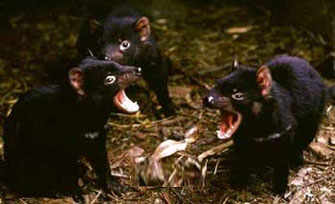
Australian-animals.net | The Tasmanian Devil is the largest carnivorous (eats meat) marsupial (a mammal that has its babies in a pouch) in Australia. Tasmanian Devils are a nocturnal (active at night) animal. lives alone and prefers its own company hence it is a relatively shy animal
Tassie devil on the move DESCRIPTION
The Tasmanian Devil is usually black with a white "collar" or patch around its neck. It is the size of a small terrier dog very solid and "stout" and weighs in between 6 and 8 kgs It has a tail of between 9 to 12" long. Tasmanian Devils have an extremely

large powerful head with a wide jaw with sharp teeth pointy pink ears (that turn red when angry due to increased blood flow) and piercing dark eyes
Its dark colouring helps it to move around unseen at night time (feeding time)
LOCATION & HABITAT
The Tasmanian Devil is now only found on the island state of Tasmania and lives in coastal scrub and eucalypt forests. It is a scavenger so Tasmanian Devils are also found near human settlements
They spend the daytime out of sight sleeping in dens lined with grass and leaves made in hollow logs, or old wombat burrows or small natural caves They can conserve energy by going into a state of "Tupor" where its body heat drops to match its surroundings
See my Pygmy Possum page for more about Torpor

FIGHTING
Tasmanian Devils by nature are not aggressive until it comes to food. Then they are protective of its find and / or kill even to the extent of killing another Devil that wanted its catch. These fights result in many a Tasmanian Devil having bald patches of missing fur and appearing battle-scarred.

click for info on pics Eating with sharp teeth
EATING
Tasmanian Devils prefer to eat carrion, that is dead animals. They will eat anything lying around no matter how old and rotten, and their powerful jaws will help them crush bones so they can devour the whole carcass, meat, fur and bone, leaving nothing to pollute the environment. They can though kill their own prey such as snakes, birds, rodents,lizards, and small wallabies and lamb. it prefers to prey on animals smaller than itself It kills by inflicting a powerful bight onto the back of the neck or back of its victim It also needs to drinks water.
SCREAMING
Group of 3 Tasmanian Devils are very loud especially when there are a number of them at the one carcass, trying to scare each other off. They have a range of sound, from barks to snorts to growling to screaming !. This screaming and their fierce looks gave birth to their "Devil" name

BREEDING
Breeding occurs at the males den which the female visits for a period of 2 weeks or so. Tasmanian Devil babies (Joeys) are born blind and deaf and little more than a grain of rice in size.
Up to 50 are born, who then race (distance of 3 inches) from the birth canal to the mothers backward facing pouch (So dirt doesn't enter when she is digging) to attach themselves to only one of four teats available !
Once sucking commences the nipple swells to form an air tight connection to the joey.
They remain attached to the nipple for around 3 months Once they leave the pouch they are firstly left in the nest whilst their mother goes for food, and then progress to going out closely accompanied by their mother After 6 months from birth the joey becomes independent of the mother A lot of joeys and juveniles do not make it to adulthood, due mainly to being attacked by adult Tasmanian Devils If hey do survive their growing year Tasmanian Devils have a lifespan of around 8 years
PAST PRESENT FUTURE
The Tasmanian Devil used to be found all over Australia. It is believed the Dingo (Australian Wild Dog) was a major reason for the decline of the Tasmanian Devil on the mainland by competing for the same food source.
Devil Location But because the Dingo did not make it over Bass strait to the Island of Tasmania (a State of Australia) the Devil survived.
Tassie Devil in motion The Tasmanian Devils numbers were very low due to them being killed by both settlers (who thought the Devil was responsible for major stock losses) and bounty hunters (who were paid by the government by the number of Devils they killed). The Tasmanian Tiger was also a predator of the Tasmanian devil. Now with the Tiger extinct, and protection from the government, as well as being appreciated by farmers (due to the Devil eating crop eating rodents & cleaning up carrion) their numbers have stablised, and are now on the increase.
THREATS
Tasmanian Devils are often hit by cars as they feed on road killed animals, and they are losing parts of their habitat due to mans increasing use of their environment Accidents and disease also account for some losses, and as already mentioned many juvenile devils are attacked by adult Devils
www.AstroDigi.com (Nino Guevara Ruwano)

cheap nike shoes
ReplyDeleteugg boots sale
ray-ban sunglasses
nba jerseys
ugg boots
louis vuitton,borse louis vuitton,louis vuitton sito ufficiale,louis vuitton outlet
rolex watches,rolex watches,swiss watches,watches for men,watches for women,omega watches,replica watches,rolex watches for sale,rolex replica,rolex watch,cartier watches,rolex submariner,fake rolex,rolex replica watches,replica rolex
christian louboutin outlet
michael kors uk
oakley canada
ralph lauren outlet
tods shoes
michael kors uk
rolex watches,rolex,watches for men,watches for women,omega watches,replica watches,rolex watches for sale,rolex replica,rolex watch,cartier watches,rolex submariner,fake rolex,rolex replica watches,replica rolex
snapbacks wholesale
toms outlet store
hermes outlet
air force 1 shoes
tory burch outlet online
chicago blackhawks
mm1224
michael kors handbags here
ReplyDeletemichael kors outlet much
armani exchange outlet stationery
toms shoes at
michael kors handbags been
bears jerseys was
cheap jordan shoes my
cheap ray bans below
packers jerseys Five